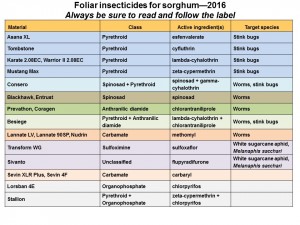Headworms: Corn earworm (CEW) is the primary headworm pest of Virginia sorghum and this summer CEW populations are higher than in the past two years. Sorghum heads are very attractive to worms—but not until the seed begins to form. I suggest that sorghum is so attractive to this pest that every field will be infested at some point. If you are not scouting your sorghum fields for CEW and not treating, it is very likely that heads are being damaged. And, not only do worms do direct damage to the developing seed, damaged seed are more likely to be infested by the fungi that produce mycotoxins which can further degrade seed quality.
So bottom line, scout fields and sample heads for worms by shaking heads into a white or light colored 5-gal bucket. In our experience, this is the ONLY way to get an accurate count. The standard headworm threshold across the U.S. is an average of 1 to 2 worms per head during seed formation.
What to treat with? We have been monitoring CEW for pyrethroid insecticide resistance for several years by collecting and testing adults (moths). This year is no exception. Individual moths are exposed to a pyrethroid and we document the percent that survive (=resistant). This year we are seeing high levels of survivorship averaging about 40% over all sample dates and locations. This means that to achieve good CEW control, non-pyrethoids insecticides should be considered. Posted below is a link to a list of insecticides labeled for use in sorghum. For CEW, I would focus on those that ‘specialize’ in worm control (like Prevathon, Besiege, or Spinosad). Lannate is another option but has essentially zero residual activity, whereas the others should provide several days of protection, depending on rainfall amounts and frequency.
Aphids: We have posted several advisories about the sugarcane aphid (SCA) infestation in our sorghum. Bottom line, fields need to be scouted following the procedures and thresholds provided in the linked fact sheet. Only Sivanto or Transform insecticides are known to be really effective against this aphid species.
Fields with CEW and SCA: If thresholds of both pests are found, insecticide tank mixes are the only option—to include a CEW product as mentioned above, and either Sivanto or Transform for SCA. Of course this adds a lot to the cost of producing sorghum. More details on both headworms and aphids can be found at this link. Midseason sorghum insect pests

